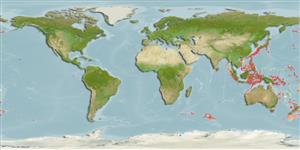>
Anguilliformes (Eels and morays) >
Muraenesocidae (Pike congers)
Etymology: Gavialiceps: Hindi, ghariyal = gavial, saurian of Ganges, 1825 + Greek, kephale = head (Ref. 45335); javanicus: Named after its type locality (Ref. 44791).
Environment: milieu / Zona climática / intervalo de profundidade / distribution range
Ecologia
marinhas batidemersal; intervalo de profundidade 560 - 600 m (Ref. 44791). Deep-water
Indo-West Pacific: Java, Indonesia and northwestern Australia.
Tamanho / Peso / Idade
Maturidade: Lm ? range ? - ? cm
Max length : 89.0 cm TL macho/indeterminado; (Ref. 44791)
Descrição suscinta
Chaves de identificação | Morfologia | Morfometria
Dark brown, the back is darker than the belly. Peritoneum, gill and mouth cavities are dark and show through the skin. Stomach is bright, does not reach above the anus, its length is 2.1 times the length of the head (Ref. 44791).
Body shape (shape guide): eel-like.
Ciclo de vida ou comportamento de acasalamento
Maturidade | Reprodução | Desova | Ovos | Fecundidade | Larvas
Karmovskaya, E.S., 1994. Systematics and distribution of the eel genus Gavialiceps (Congridae) in the Indo-West Pacific. J. Ichthyol. 34(3):73-89. (Ref. 44791)
Status na Lista Vermelha da UICN (Ref. 130435: Version 2025-1)
Ameaça para os humanos
Harmless
Uso pelos humanos
Ferramentas
Relatórios especiais
Baixar XML
Fontes da internet
Estimates based on models
Preferred temperature (Ref.
123201): 2 - 8.8, mean 7.6 °C (based on 26 cells).
Índice de diversidade filogenética (Ref.
82804): PD
50 = 0.5313 [Uniqueness, from 0.5 = low to 2.0 = high].
Bayesian length-weight: a=0.00155 (0.00068 - 0.00355), b=2.92 (2.72 - 3.12), in cm total length, based on LWR estimates for this (Sub)family-body shape (Ref.
93245).
Nível Trófico (Ref.
69278): 3.9 ±0.6 se; based on size and trophs of closest relatives
Resiliência (Ref.
120179): médio(a), tempo mínimo de duplicação da população 1,4 - 4,4 anos (Preliminary K or Fecundity.).
Fishing Vulnerability (Ref.
59153): High vulnerability (56 of 100).
🛈
